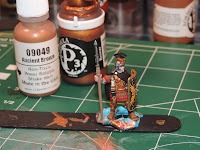 I've begun my elite Praetorian Guards minis. This is my first one; trying out different colors for the armor and tunic, etc. Finally this pattern strikes me as a good balance of a Praetorian Guard soldier field uniform that maintains the allure of the palace Praetorian dress uniform. Used Ancient Bronze Masters Series Paint for the breastplate, leg greaves and helmet accent.
I've begun my elite Praetorian Guards minis. This is my first one; trying out different colors for the armor and tunic, etc. Finally this pattern strikes me as a good balance of a Praetorian Guard soldier field uniform that maintains the allure of the palace Praetorian dress uniform. Used Ancient Bronze Masters Series Paint for the breastplate, leg greaves and helmet accent. Still have some light paint touching up to do (e.g. the Pilum with P3's Beast Hide) and then I will gloss poly seal the mini for the follow-up Army Painter Dip "dipping" and then Litko basing (will probably base 2 minis each) then matte varnish to finish.
Of Note: The initial purpose of the Praetorian Guards differed greatly from the later Guards, which came to be a vital force in the landscape of Rome. While Emperor Augustus understood the need to have a protector force in the maelstrom of Rome, he was careful to uphold the Republican veneer of his regime. Thus he allowed only nine Guards Cohorts to be formed, originally of 500, then increased to 1,000 men each, and only three were kept on duty at any given time inside the capital. A small number of detached Praetorian cavalry units (called Turmae) of 30 men each were also organized. The 3 Cohorts patrolled in the palace and around major buildings, while the others were stationed in the towns surrounding Rome. This system was not radically changed with the appointment by Augustus in 2 BC of two Praetorian Prefects, Quintus Ostorius Scapula and Publius Salvius Aper, although the organization and command were vastly improved.
Later, through the machinations of an ambitious Praetorian Prefect, Lucius Aelius Sejanus, the remaining outlying Cohorts were brought into barracks closer to Rome itself. In AD 23, Sejanus convinced Tiberius to have the Castra Praetoria (the fort of the Praetorians) built just outside of Rome. Henceforth the entire force was at the disposal of the Emperors, but the rulers were now equally at the mercy of the Praetorians. The reality of this was seen in AD 31 when Tiberius was forced to rely upon loyal Praetorian Cohorts against other Cohorts loyal to Perfect Sejanus. Although the Emperor's loyal Praetorian Guards eventually proved out to the aging Tiberius, their potential political power and danger had been established (something Emperor Caligula would later discover to his peril in AD 41 when he was assassinated by the Praetorians).
While campaigning, the Praetorian Guard Cohorts were the equal of any formation in the Roman Army. On the death of Emperor Augustus in AD 14, his successor Tiberius was faced with mutinies among both the Rhine and Pannonian Legions. According to Tacitus, the Pannonian forces were dealt with by Tiberius' son Drusus, accompanied by two Praetorian Cohorts, the Praetorian cavalry and some of the German bodyguard. The German mutiny was put down by Tiberius' stepson Germanicus, his intended heir, who then led the Legions and detachments of the Guards in an invasion of Germany over the next two years (and achieved revenge for the massacre of 3 Legions at the Battle of Teutoburg Forest). The Guard was quite active circa AD 69; they fought well at the first Battle of Bedriacum for Otho. Under Emperors Domitian and Trajan, the Praetorian Guard Cohorts took part in wars from Dacia to Mesopotamia, while with Emperor Marcus Aurelius, years were spent fighting on the Danubian frontier. Throughout the 3rd century, the Praetorian Cohorts assisted the Emperors in various campaigns.




































